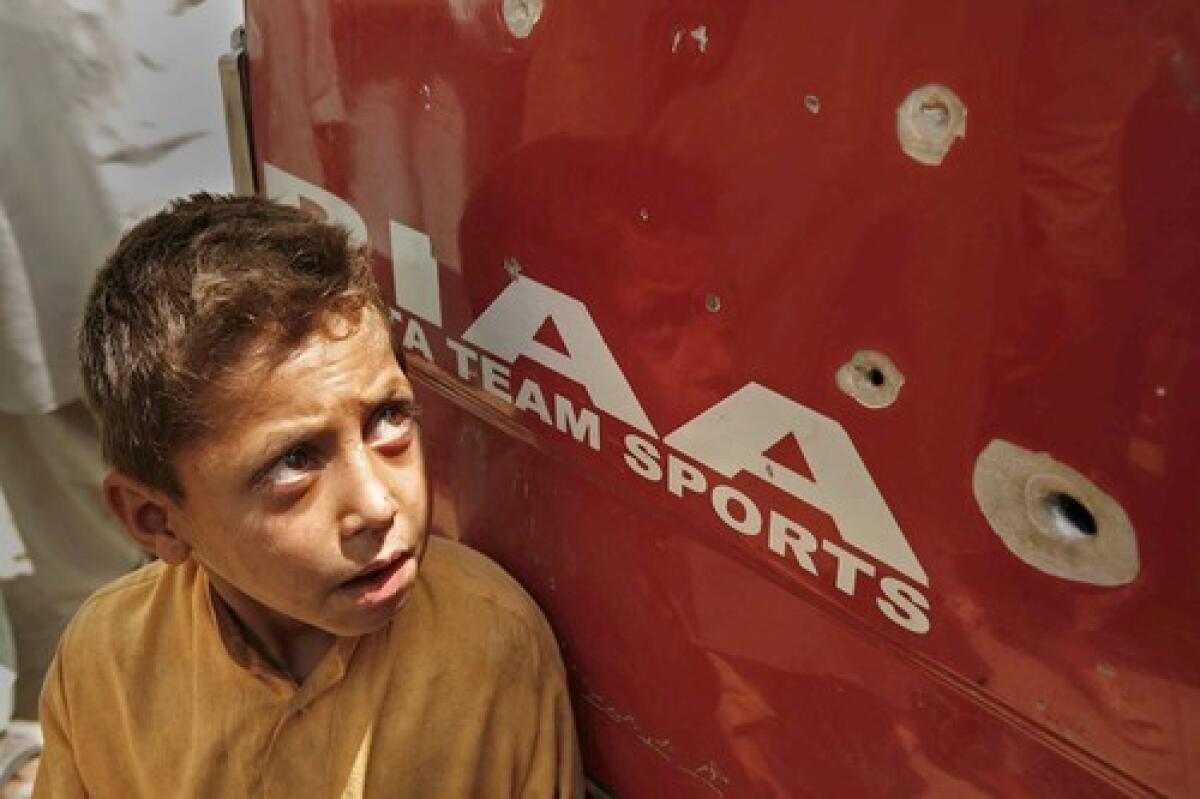Pakistani civilians caught in the crossfire

- Share via
Reporting from Muhib Banda, Pakistan — There was little time to think. With bursts of gunfire ringing out from overhead, three families found themselves trapped in farmer Mir Kamal’s candy red minivan, unable to escape.
Bullets tore through the roof, the rear window and side panel, hitting some of the children inside. Kamal ordered his wife and children out, hoping the sight of them would stop the gunfire.
Eventually, it did. But not before more of them were hit, one fatally.
Days later in this brick-hut hamlet, where his family has taken refuge in a dusty school building, Kamal tries to understand what happened May 19 outside his village of Pir Baba in the Buner district of northwestern Pakistan. The government had declared the area cleared of Taliban militants and said it was safe to return.
Why, if his village was safe, did his family find itself caught in a hail of gunfire? Why did the gunfire appear to be coming from Pakistani military helicopters? Why did his daughter, 15-year-old Zainab, have to die?
“They said it was OK, that we could go back,” said Kamal, 35, seated on a rattan bench in a dirt-floor hut surrounded by a dozen relatives and friends who had come to offer condolences over the death of Zainab. “And when we went back, they opened fire. Innocent people were the ones suffering.”
“Bullets were raining,” added Kamal, a rail-thin wheat farmer speaking excitedly in his native Pashto, the language of the region. “The dust was kicking up everywhere. It was like doomsday.”
Kamal and two passengers in his van say the gunfire came from two military helicopters. Bullet holes are evident in the minivan’s body, rear window and seats, but it is impossible to determine where they came from or when the damage occurred.
A military spokesman, Maj. Faisal Rehman, denied that the event happened. Another military source, who requested anonymity, said: “We don’t attack civilians, it’s as simple as that. If someone claims someone died, they must be telling the truth. But the point is where the fire came from.”
The episode illustrates the volatility gripping areas of northwestern Pakistan, where the army has launched its latest offensive to quell a growing insurgency.
The district of Buner, located just south of the Swat Valley, was one of the first places Pakistani gunships and troops focused on as they began a push to root out Taliban militants late last month. And with an exodus of civilians creating a humanitarian crisis, officials have been eager to allow refugees to return to villages and towns that have been cleared of Taliban militants.
On May 17, Pakistani media and international news agencies quoted Interior Minister Rehman Malik as saying that it was safe to return to Buner. “The government will provide full protection to these people,” he said.
Families such as Kamal’s that had wheat fields to harvest were particularly eager to go back.
But it was less calm than the government had said. Two days after Malik spoke, Pakistani troops stormed the town of Sultanwas, only two miles from Pir Baba. Military spokesman Maj. Gen. Athar Abbas said at least 80 Taliban insurgents were killed in the fighting, along with one soldier. Troops found several concrete bunkers built by the Taliban to fortify their positions, he said.
Amanul Mulk, a 25-year-old engineer from Sultanwas, said his family sent a relative to survey the situation. The relative found that the family’s seven homes had been looted by the Taliban and then set ablaze.
“Then they blew them up,” Mulk said. “They’re piles of rubble now. In the rest of Sultanwas, about 80% of the town is destroyed.”
The proximity of Sultanwas raises the possibility that Kamal and the others were swept up in the chaos of battle.
When they arrived back in Pir Baba, Taliban fighters were still in the area. There was no electricity, and there were no laborers to help Kamal with his harvest. Bodies were scattered on the pavement.
Kamal and the other families stayed a few days, and decided to leave May 19 -- when curfew restrictions were relaxed. The families piled into Kamal’s minivan and a Suzuki that followed behind.
About a mile out of Pir Baba, near the village of Bhai, Kamal saw the burned-out frame of a Mazda van, along with bodies on the ground. Moments after he parked his van underneath a roadside shelter and the Suzuki pulled up alongside, the helicopters appeared, he said.
Kamal’s two sons were shot in the leg.
A 10-year-old girl, Hidayat Gul, of one of the other families, was hit three times when she stepped out of the van -- in the knee, the thigh and calf.
“We all came out of the cars to signal that there were women and children here and to stop firing,” said Mohammed Rahim, 21, a passenger in Kamal’s van. “Finally they stopped firing.”
Shot in the hip, Zainab was still alive when Kamal rushed her and the other injured to the nearest hospital. She died along the way, he said.
Kamal said his family wouldn’t return to their amber wheat fields in Buner. Instead, they will be among the 100 displaced people sharing a five-room school building here. And they’ll look for menial labor to support themselves.
More to Read
Sign up for Essential California
The most important California stories and recommendations in your inbox every morning.
You may occasionally receive promotional content from the Los Angeles Times.










